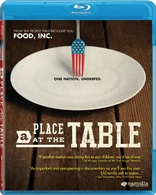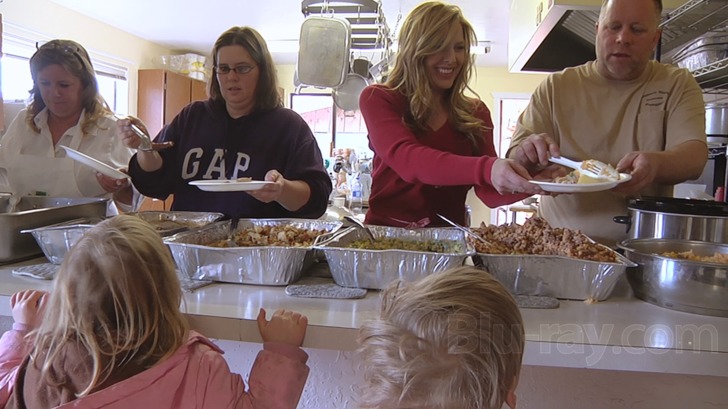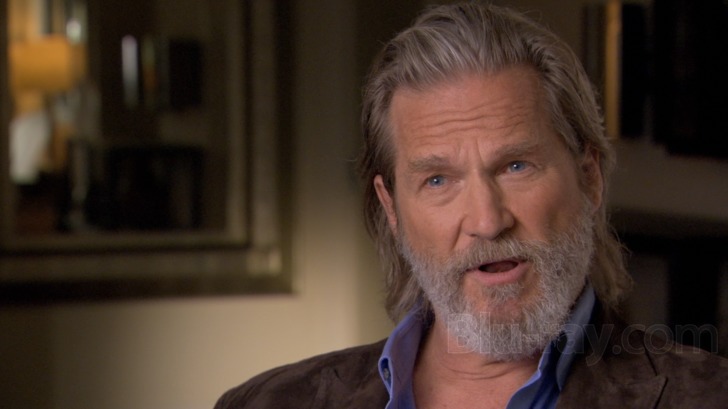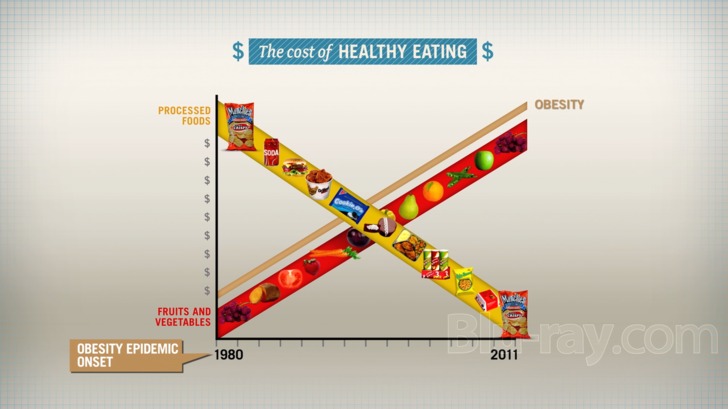A Place at the Table Blu-ray Movie
HomeA Place at the Table Blu-ray Movie 
Magnolia Pictures | 2012 | 84 min | Rated PG | Jun 25, 2013
Movie rating
6.5 | / 10 |
Blu-ray rating
| Users | 0.0 | |
| Reviewer | 4.0 | |
| Overall | 4.0 |
Overview
A Place at the Table (2012)
A Place at the Table examines the shocking paradox of hunger in the wealthiest nation on earth, through the stories of three Americans who face food insecurity daily.
Starring: Jeff BridgesDirector: Kristi Jacobson, Lori Silverbush
| Documentary | 100% |
Specifications
Video
Video codec: MPEG-4 AVC
Video resolution: 1080p
Aspect ratio: 1.78:1
Original aspect ratio: 1.85:1
Audio
English: DTS-HD Master Audio 5.1
Subtitles
English SDH, Spanish
Discs
25GB Blu-ray Disc
Single disc (1 BD)
Playback
Region A (B, C untested)
Review
Rating summary
| Movie | 4.0 | |
| Video | 3.0 | |
| Audio | 4.0 | |
| Extras | 3.0 | |
| Overall | 4.0 |
A Place at the Table Blu-ray Movie Review
"The answer is widespread governmental programs focused on the human being."
Reviewed by Casey Broadwater June 25, 2013If you ask a random person on the street to list some of the biggest issues in contemporary American life, you'll likely get the usual woes: the
economy, national defense, terrorism, health care, maybe even gun rights or abortion policy, depending on the individual and their socio-political
leanings. It's doubtful anyone would mention hunger in their top-10. I mean, this is the United States we're talking about, not sub-Saharan Africa. But
that only goes to show just how underreported and glossed over the problem of hunger in the U.S. really is. The actual numbers are staggering, with
50 million Americans unsure how and when they'll get their next meal, a situation nutrition experts refer to as "food insecurity." Even more surprising,
food insecurity rates have risen sharply since the 1980s, even adjusted for population growth.
This isn't a problem we've fixed, it's one we've let fester, largely ignored by the media and given only lip service by politicians. It wasn't always so. In
1968, CBS News Hour ran the influential, Edward R. Murrow-directed documentary Hunger in America, which opened with a shot of a
premature baby dying of malnutrition—literally dying, right there onscreen—and went on to galvanize political interest in ending hunger. With their
documentary A Place at the Table—produced by Participant Media, the same company that brought us Food, Inc.—directors Kristi
Jacobson and Lori Silverbush are hoping to have the same kind of effect.

What they lack in visual impact—no low-blow shots of dying infants here—they make up in terrifying facts and well-reasoned arguments, presented by a host of talking heads, from nutrition researcher Dr. Mariana Chilton and Stuffed and Starved author Raj Patel, to Top Chef cohost Tom Colicchio and actor Jeff Bridges, founder of the End Hunger Network. Collectively, the filmmakers and their assembled experts take a comprehensive look at the problem, turning it over and examining it from all sides.
The first facet is the seemingly contradictory correlation between hunger and obesity. "They're both signs of having insufficient funds," says Patel, and this ties in to the larger issue of the governmental farming subsidies that were initially enacted during the Great Depression to help struggling family farmers. The assistance programs were never rescinded, however, and now they fund the large scale agribusiness corporations that produce the artificially cheap wheat and corn that ends up in the artificially cheap processed foods that poor people tend to buy over more expensive—and healthier —fruits and vegetables. Patel notes the irony: "There's this weird paradox, where welfare for the poor is scorned but corporate welfare—as it's known— is heartily endorsed."
A single graph shows us everything we need to know; while processed foods have gone down in cost 40% since 1980, fresh produce has gone up a nearly identical percentage. Thus, you have poor children who are massively overweight from carbs and sugars but also starving because they're not getting the nutrients they need to develop normally. We learn the stomach-churning fact that one in three children born in the year 2000 will develop type-2 diabetes, and this is only the beginning of the mental and physical problems that the one-two punch of hunger and obesity can cause. "It's just appalling," Bridges says. "If another country were doing this to our kids, we'd be at war."
To put real-world faces on the issues of food insecurity and malnutrition, which might be reduced to overwhelming abstractions otherwise, Jacobson and Silverbush follow three underprivileged families—in backcountry Colorado, rural Mississippi, and urban Philadelphia—to see exactly what it takes to get by week-to-week. Considering the average food stamp benefit is only $3 per day—and one of the families doesn't even qualify for assistance—it basically amounts to buying the absolute cheapest, least-healthy food in the supermarket and relying on the help of friends and non-profit organizations whenever possible.
The film wants to shatter the two-fold, distinctly American myth that a.) poor people somehow deserve to be hungry, and b.) that charities can solve hunger better than the government. This isn't to demean the work done by charities at all. A Place at the Table shows the good that can come out of community food banks and church meal programs, but the numbers don't lie. Charities are overwhelmed. In 1980, there were only 200 food banks in the U.S. Now, there are over 40,000, but the hunger problem is only getting worse. Dr. Chilton sees food banks as a quick fix: "We call it emergency food? It's no longer emergency food. This is called the chronic use of a broken system for which people cannot be held accountable."
What's the solution? On a broad scale, the film suggests that we need to reconsider many of our national priorities—why spend so much on the military and so little on public school lunches, for instance—and ultimately realize as a society that having healthy, affordable food benefits us all. Though this "for the greater good" sentiment obviously doesn't sit well with certain groups—the agriculture industry, namely, as well as those who think it smacks of socialism—A Place at the Table wants to raise awareness so that public interest might eventually outweigh corporate concerns when it comes to affecting legislation and policy. In its last fifteen minutes, the film perhaps bites off more than it can chew when it shifts the topic from "Why are people hungry?" to "Why are people poor?," but this does leave us thinking about living wages, income inequality, and what some would derogatorily call "class warfare." I think Jacobson and Silverbush might already have the topic for their next film.
A Place at the Table Blu-ray Movie, Video Quality 

A Place at the Table takes a seat on Blu-ray with a 1080p/AVC-encoded presentation that's true to source, although those sources can differ drastically throughout the film. The locked-down interview segments look best—decently sharp and detailed—while some of the handheld material following the three families can be much softer and flatter. (At times, it even looks upscaled, with fuzzy edges and muddled textures.) And then there's the occasional stock footage, which is mostly in high definition, although there are a few noticeably standard definition shots in there as well. (Can we finally stop calling standard definition "standard," seeing as how it's not the standard anymore?) Overall, the documentary is very watchable, although you will spot lots of the usual low-budget, shot-on-inexpensive-video quirks—some blown-out highlights, some light banding, some macroblocking, etc. There's no reason to try and pick this one apart; you're not really watching A Place at the Table for the visuals.
A Place at the Table Blu-ray Movie, Audio Quality 

Likewise, the film's front-heavy DTS-HD Master Audio 5.1 surround track does exactly what it needs to do. The most important thing here is that the interviewees' voices come through cleanly and clearly—they do—and so everything else is just a bonus. The rear speakers are used only sparsely for ambience, but the soundfield is filled every few minutes with songs by The Civil Wars and T-Bone Burnett. (Expect lots of picked acoustic guitars and plaintive singing.) The disc includes optional English SDH and Spanish subtitles, which appear in easy-to-read white lettering. No issues here whatsoever.
A Place at the Table Blu-ray Movie, Special Features and Extras 

- Audio Commentary: With producer Tom Colicchio and directors Kristi Jacobson and Lori Silverbush.
- Deleted Scenes (HD, 12:55): Four deleted/extended scenes with the various families demonstrating what it takes to get by.
- Deleted Interviews (HD, 13:45): Additional interview footage with Jeff Bridges, Tom Colicchio, and Adam Appelhanz.
- Cast and Crew Interviews (HD, 37:43): Interviews with Tom Colicchio, Kristi Jacobson, and Lori Silverbush.
- AXS TV: A Look at A Place at the Table (HD, 2:59): A short featurette for the AXS TV channel.
- A Good Day (HD, 2:15): A stop-motion advertisement for a campaign to help end hunger.
- The Full Effect: Plum Organics' Mission to Nourish Children Across America (HD, 3:59): A promo for Plum Organics, a healthy baby food line.
- Theatrical Trailer (HD, 2:27)
- Also from Magnolia Home Entertainment (HD, 6:41)
A Place at the Table Blu-ray Movie, Overall Score and Recommendation 

One of the most poignant shots in the film is of a Paula Dean billboard in Mississippi that simply reads "Hungry Ya'll?" as one of the experts describes how the state is is #1 in the U.S. for both obesity and food insecurity. That really says it all. We've got a systemic hunger/nutrition issue in America, and it's going to take intense pressure from average joe citizens to sway politicians away from the agricultural special interest groups who have made unhealthy processed foods unreasonably cheap and fresh produce irrationally expensive. The first step, of course, is realizing that there is a problem, and that's what A Place at the Table sets out to do—raise awareness. If Food, Inc. made you simmer, this one will bring you to a boil. Highly recommended!
Similar titles
Similar titles you might also like

America: Imagine the World Without Her
2014

Food, Inc.
2008

Why We Fight
2005

Stephen Fry in America
2007

Waiting for "Superman"
2010

American Experience: Freedom Riders
2011

An Inconvenient Sequel: Truth to Power
2017

Capitalism: A Love Story
2009

Fahrenheit 11/9
2018

RBG
2018

I Am Not Your Negro
2016

Where to Invade Next
2015

The Wolfpack
2015

Citizenfour
2014

Sicko
2007

Bowling for Columbine
2002

Whitey: United States of America V. James J. Bulger
2014

Dinosaur 13
Director's Cut
2014

Forks Over Knives
2010

Prohibition
2011